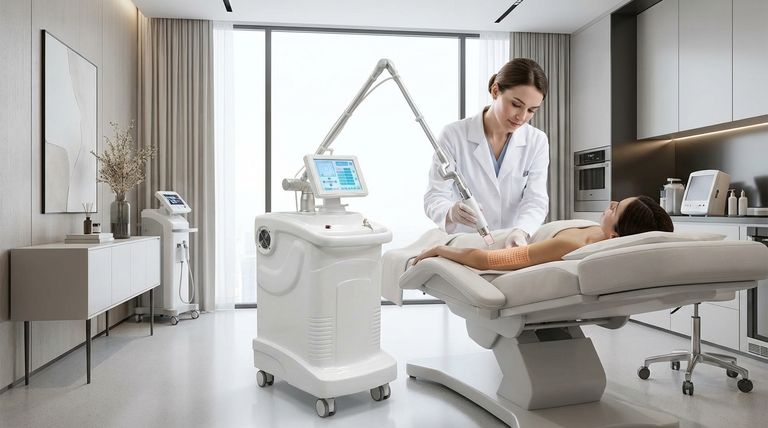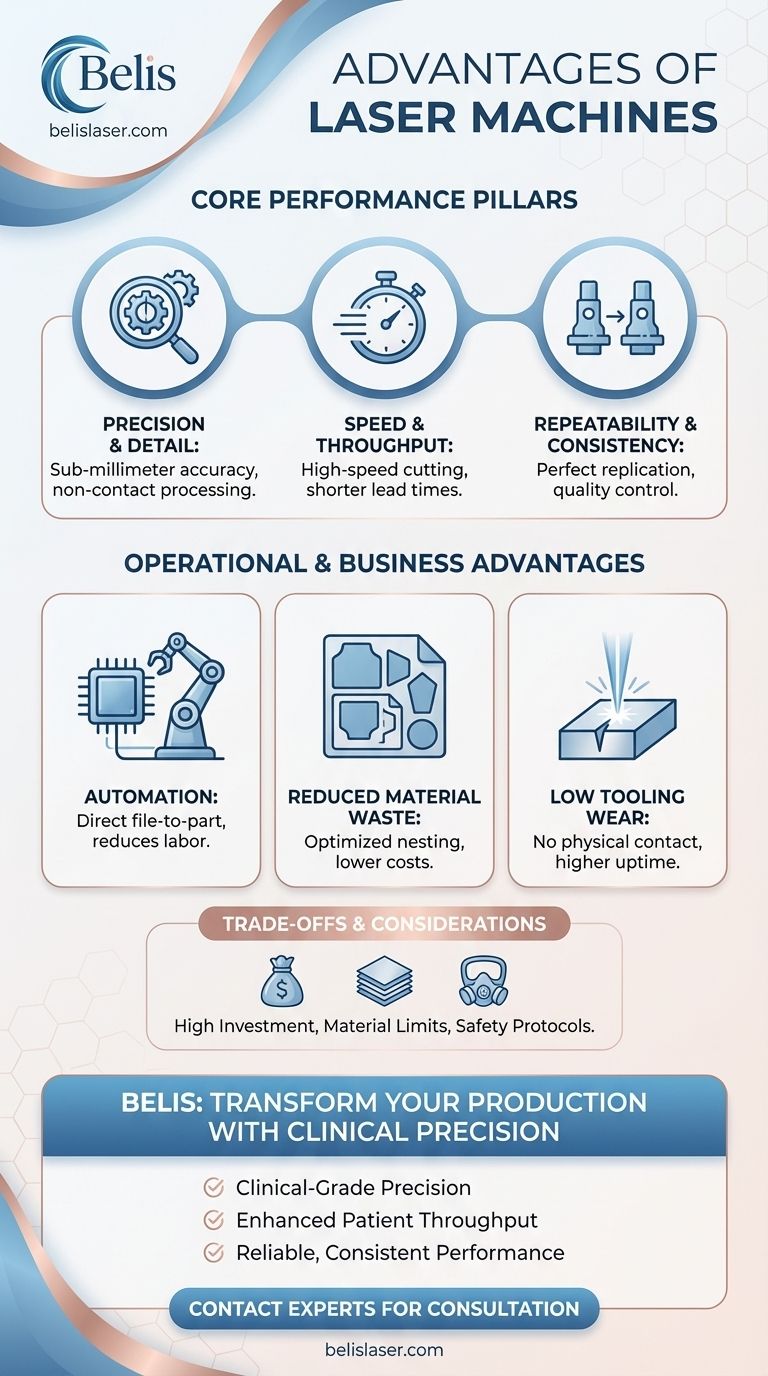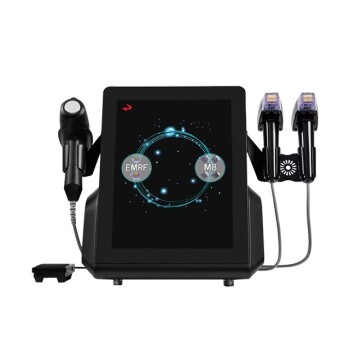The primary advantages of a laser machine are its exceptional precision, high processing speed, and the ability to consistently repeat complex operations with minimal human intervention. This unique combination of speed and accuracy makes it a transformative tool for both rapid prototyping and large-scale manufacturing.
A laser machine's true advantage lies in the fusion of digital precision with physical speed. This allows for complex designs to be produced with near-perfect consistency, fundamentally increasing both production capability and operational efficiency.

The Core Pillars of Laser Performance
To understand the impact of laser technology, we must break down its fundamental performance characteristics. These are not just features, but foundational capabilities that enable new ways of working.
Unmatched Precision and Detail
A laser's focused beam can create cuts, engravings, and markings with extremely tight tolerances, often measured in fractions of a millimeter.
Because the process is non-contact, there is no physical force exerted on the material, preventing warping or damage to delicate components. This results in clean edges and intricate details that are impossible to achieve with traditional mechanical tools.
Speed and Throughput
Laser machines operate at very high speeds, dramatically reducing the time it takes to cut or engrave parts compared to manual methods.
This high throughput directly translates into lower cost-per-part and shorter lead times, making it ideal for meeting demanding production schedules.
Repeatability and Consistency
Once a design is programmed, a laser machine can execute it thousands of times with virtually no deviation. The first part produced is identical to the last.
This repeatability, as noted in production analysis, is critical for quality control in mass manufacturing, eliminating the inconsistencies inherent in manual labor.
Operational and Business Advantages
Beyond raw performance, laser systems offer significant benefits that streamline operations and improve the bottom line.
The Power of Automation
Laser machines are controlled by computer software, directly interpreting digital design files (like DXF, AI, or SVG). This removes the need for manual tool setup or guide creation.
This level of automation reduces the need for constant operator oversight, freeing up skilled labor for higher-value tasks and minimizing the potential for human error.
Reduced Material Waste
The extreme precision of the laser beam allows for parts to be "nested" very closely together on a sheet of material.
This efficient layout planning significantly reduces scrap material, which is a direct cost saving, especially when working with expensive materials.
Low Tooling Wear
The "cutting tool" is a beam of light, which does not dull, break, or wear out like a physical drill bit or saw blade.
This eliminates downtime and costs associated with tool replacement and sharpening, leading to higher machine uptime and lower maintenance overhead.
Understanding the Trade-offs
No technology is a universal solution. An objective evaluation requires acknowledging the limitations and operational requirements of laser systems.
High Initial Investment
Professional and industrial-grade laser machines represent a significant capital expenditure. The upfront cost can be a barrier for small shops or hobbyists.
Material Limitations
While versatile, lasers have limitations. Highly reflective metals like copper can be difficult to process, and the thickness of the material a laser can cut is finite. For very thick metal plates, technologies like plasma or waterjet cutting may be more suitable.
Fumes and Safety Requirements
The process of vaporizing material (ablation) creates fumes that must be properly ventilated and filtered for operator safety and environmental compliance.
Furthermore, high-power lasers require strict safety protocols, including specialized eye protection and enclosed work areas, to prevent accidental injury.
Making the Right Choice for Your Goal
To determine if a laser is the right tool, align its advantages with your primary objective.
- If your primary focus is rapid prototyping or custom products: The laser's ability to instantly turn a digital file into a physical object makes it the ideal tool for fast iteration and one-off creations.
- If your primary focus is high-volume manufacturing: The laser's speed, automation, and perfect repeatability will drastically increase your throughput while ensuring consistent quality.
- If your primary focus is intricate design work: The laser's unmatched precision allows you to produce fine details and complex geometries that are simply not feasible with other methods.
Ultimately, a laser machine empowers you to translate digital designs into physical reality with unparalleled speed and accuracy.
Summary Table:
| Advantage | Key Benefit | Impact |
|---|---|---|
| Precision & Detail | Non-contact processing, sub-millimeter accuracy | Clean edges, intricate details, no material damage |
| Speed & Throughput | High-speed cutting/engraving | Lower cost-per-part, shorter lead times |
| Repeatability & Consistency | Perfect replication of designs | Essential for mass production quality control |
| Automation | Direct file-to-part processing | Reduces labor, minimizes human error |
| Material Efficiency | Optimized nesting on material sheets | Significant reduction in scrap and material costs |
| Low Maintenance | No physical tool wear | Higher machine uptime, lower operational costs |
Ready to Transform Your Production with Laser Precision?
BELIS specializes in providing professional medical aesthetic laser equipment, empowering clinics and premium beauty salons to deliver superior treatments with unmatched accuracy and efficiency.
Upgrade your practice with technology that offers:
- Clinical-Grade Precision: Perform treatments with confidence and exceptional results.
- Enhanced Patient Throughput: See more clients efficiently without compromising on quality.
- Reliable, Consistent Performance: Build your reputation on dependable technology.
Let's discuss how a BELIS laser system can become a cornerstone of your service offerings.
Contact our experts today for a personalized consultation to find the perfect laser solution for your business goals.
Visual Guide

Related Products
- Fractional CO2 Laser Machine for Skin Treatment
- Hydrofacial Machine with Facial Skin Analyzer and Skin Tester
- Pico Picosecond Laser Machine for Tattoo Removal Picosure Pico Laser
- Clinic Use IPL SHR ND YAG Laser Hair Removal RF Skin Tightening Machine
- Hydrafacial Machine Facial Clean Face and Skin Care Machine
People Also Ask
- How often should you do fractional CO2 laser? The 4-6 Week Rule for Optimal Results
- What is a CO2 fractional laser good for? Dramatic Skin Rejuvenation for Wrinkles & Scars
- What does a CO2 laser do to your face? Achieve Profound Skin Resurfacing & Renewal
- What will my face look like after a CO2 laser? Your Complete Recovery Timeline
- Is CO2 laser for all skin types? A Critical Guide to Skin Type Safety and Risks



















